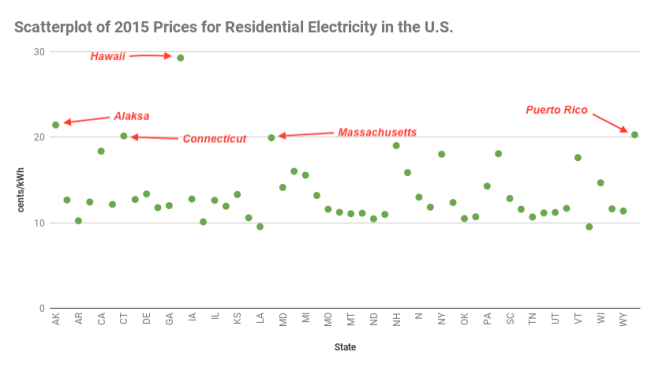Comparatively speaking, do Puerto Rico’s residents pay the highest electricity rates in the United States (U.S.)? The U.S. Energy Information Administration (EIA) collects data on the price of electricity for residential, commercial and industrial customers for all the U.S. states and, since 2014, for Puerto Rico. The 2016 and 2017 data is preliminary. Thus, for this analysis we will look at 2015 electricity rates for residential customers.
The average price of electricity for residential customers in 2015 was 12.7 cents per kilowatt-hour (kWh). The scatterplot below helps us visualize the country’s different rates. Hawaii had the highest prices at 29.3 cents kWh, followed by Alaska and Connecticut. Puerto Rico, at 20.3 cents per kWh, had the fourth highest price in the nation.

Even though this plot shows that Hawaii had the nation’s highest residential electricity rates in 2015, looking at this rate is not the best approach to see whether Puerto Ricans pay more for electricity than the residents of the other states. For that reason, we should look at how much of the median household’s income is devoted to electricity.
The U.S. Census estimates that the median household income for the U.S. was $56,516. At $40,593, Mississippi’s median household income was the lowest among the country’s 50 states. Maryland has the highest median household income at $75,847, while Puerto Rico’s median household earned around $18,626.
The median U.S. household devotes around 2.5% of its income to pay for electricity. The table below lists the 10 states which devote the least percentage of median household income towards electricity.
| States Where the Median Household Devotes the Least Percentage of Income to Electricity (2015) |
| STATE |
% OF MEDIAN HOUSEHOLD INCOME DEVOTED TO ELECTRICITY |
| Utah |
1.54% |
| Colorado |
1.57% |
| Washington |
1.64% |
| District of Columbia |
1.73% |
| Minnesotta |
1.75% |
| California |
1.76% |
| Illinois |
1.81% |
| Wyoming |
1.82% |
| New Jersey |
1.83% |
| Alaska |
1.96% |
The next table lists the 10 states where residents dedicate the highest percentage of their income to electricity.
| States Where the Median Household Devotes the Highest Percentage of Income to Electricity (2015) |
| STATE |
% OF MEDIAN HOUSEHOLD INCOME DEVOTED TO ELECTRICITY |
| Louisiana |
3.15% |
| Arkansas |
3.15% |
| West Virginia |
3.19% |
| Florida |
3.21% |
| Tennessee |
3.26% |
| North Carolina |
3.43% |
| South Carolina |
3.66% |
| Alabama |
3.82% |
| Mississippi |
4.06% |
| Puerto Rico |
5.19% |
What can we learn from this short analysis?
- While Hawaii has the country’s highest electricity rates, its median household income is $73,486. Thus, the median Hawaiian household dedicates 3% of its income to pay for electricity.
- The median Puerto Rican household, in contrast, dedicates more than 5% of its income towards electricity. This is more than double the national average, reminding us that:
- Puerto Ricans are not only devoting the highest percentage of their income towards their electricity bills.
- The median Puerto Rican household earns only $18,626, which is $37,890 less than the national average or $21,967 less than Mississippi, the U.S. state with the lowest median household income.
